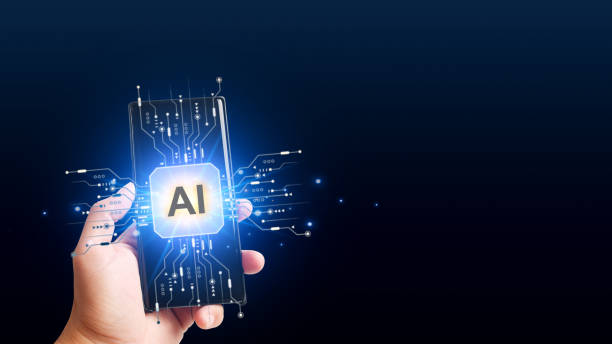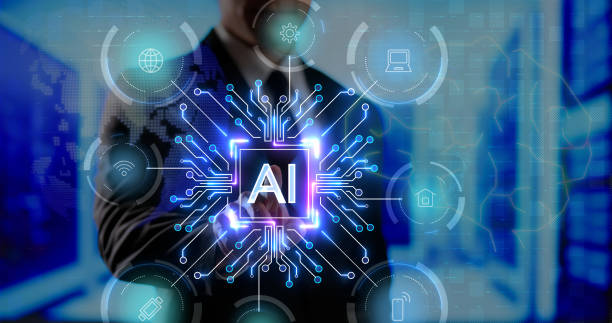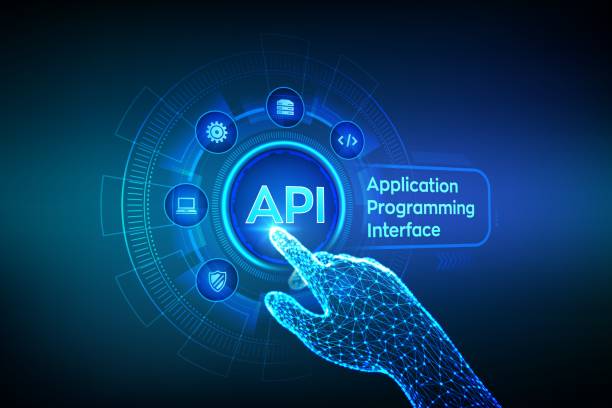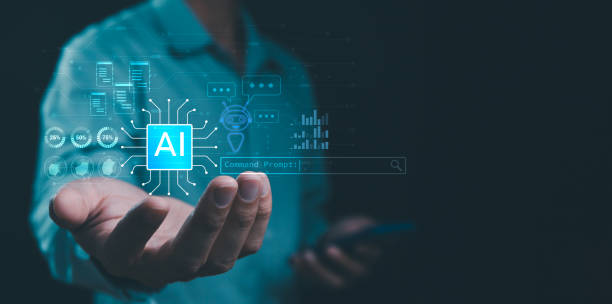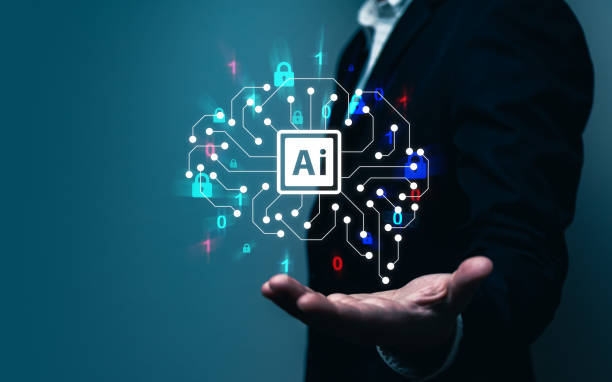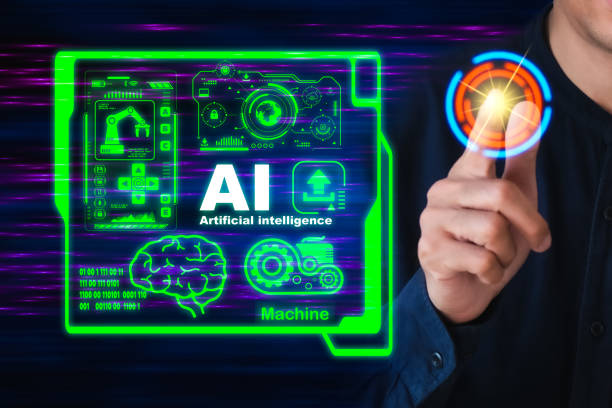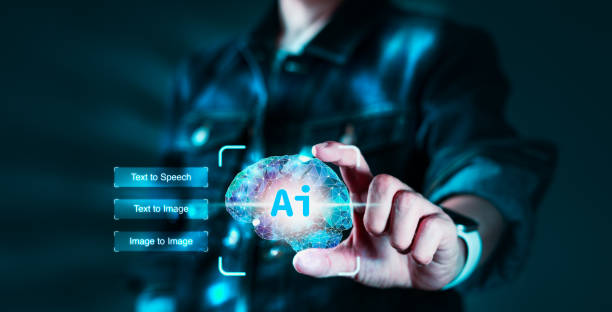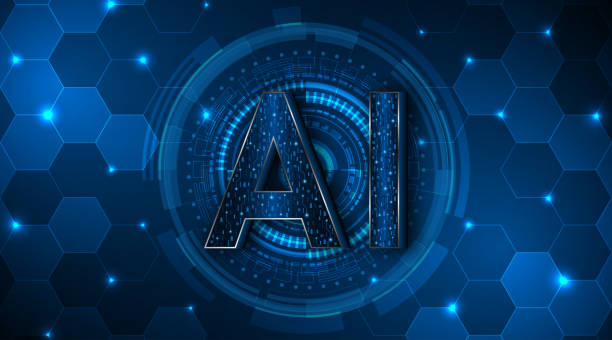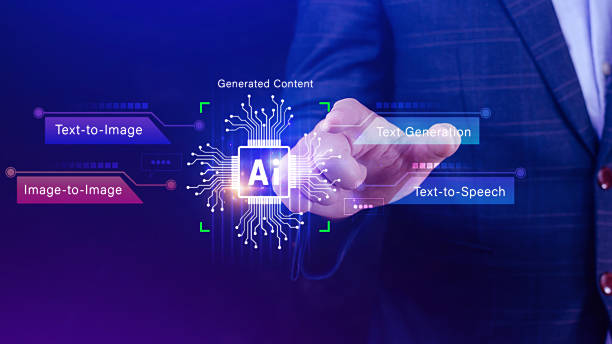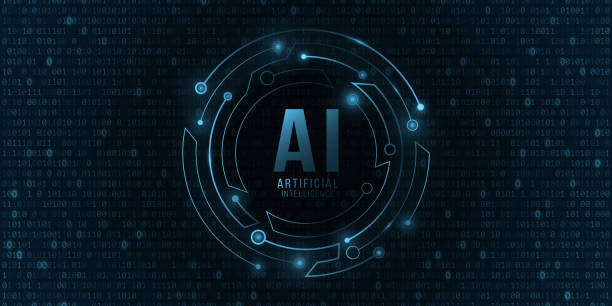What is an Artificial Intelligence Robot and How Does it Work?
#Artificial Intelligence Robot is a combination of two separate fields: robotics and artificial intelligence.
In simple terms, an AI robot is a physical or software machine that uses algorithms and AI techniques to perform tasks that require human intelligence.
These tasks can include learning, reasoning, problem-solving, pattern recognition, and decision-making.
Generally, AI robots consist of three main components: sensors, processors, and actuators.
Sensors collect information from the surrounding environment (such as cameras, microphones, and temperature and pressure sensors).
Processors (usually computers) process this information and make decisions using AI algorithms.
Actuators execute the processor’s commands and affect the physical environment (such as motors, arms, and displays).
AI robots [AI Robot Definition on Wikipedia](https://fa.wikipedia.org/wiki/%D9%87%D9%88%D8%B4_%D9%85%D8%B5%D9%86%D9%88%D8%B9%DB%8C) can be very diverse depending on their application.
The algorithms used in AI robots are very diverse and include Machine Learning, Neural Networks, Natural Language Processing, and Expert Systems.
Machine learning allows robots to learn from data and improve their performance.
Neural networks are used for pattern recognition and data classification.
Natural language processing enables robots to understand human language and communicate with humans.
Expert systems store the knowledge of human experts in the form of rules and procedures and help robots in decision-making.
Are you bothered by losing customers due to the old appearance or slow speed of your online store? The expert team at Rasaweb solves these problems with professional online store design!
✅ Increase customer trust and your brand’s credibility
✅ Stunning speed and excellent user experience
Get a free consultation with Rasaweb now ⚡
Amazing Applications of AI Robots in Today’s World
AI robots are changing the face of many industries and aspects of our lives.
From #healthcare to #manufacturing and #transportation, these robots are providing innovative solutions and increasing productivity.
In healthcare, AI robots can assist surgeons in performing complex surgeries, distribute medications more accurately, and assist patients in rehabilitation.
In the manufacturing industry, AI robots can perform repetitive and dangerous tasks, improve product quality, and reduce production costs.
In transportation, AI robots can drive self-driving cars, manage traffic, and optimize public transportation systems.
The use of AI robots in various industries is increasing day by day.
Click here to preview your posts with PRO themes ››
In addition, AI robots are entering our daily lives as well.
Voice assistants like Siri and Alexa are examples of AI robots that help us with tasks like setting reminders, playing music, and searching the internet.
Home robots are also being developed that can perform tasks such as cleaning the house, caring for children and the elderly, and providing education.
AI robots have the potential to make our lives easier, healthier, and safer.
For example, in agriculture, AI robots can use sensors and machine learning algorithms to check the condition of soil, water, and plants and make optimal decisions about irrigation, fertilization, and spraying.
This can lead to increased crop yields, reduced water and fertilizer consumption, and reduced environmental pollution.
Key Components of an AI Robot: A Specialized Review
For an AI robot to function correctly, it needs a series of basic components that allow it to interact with the environment and make intelligent decisions.
These components generally include the following:
Sensors Sensors play the role of the robot’s eyes and ears.
They collect information about the surrounding environment.
This information can include images, sounds, temperature, pressure, distance, and other physical parameters.
There are different types of sensors, and they are selected depending on the application of the robot.
Processor The processor is the brain of the robot.
Its function is to process the information received from the sensors, make decisions, and generate control commands.
The processor can be a computer, a microcontroller, or an embedded system.
The power of the processor directly affects the speed and accuracy of the robot.
For complex AI processing, powerful processors are needed.
Actuators Actuators are the muscles of the robot.
They receive control commands from the processor and cause movement and physical tasks of the robot.
Actuators can include motors, pumps, arms, wheels, and other mechanical parts.
The choice of actuators depends on the type of tasks the robot has to perform.
Click here to preview your posts with PRO themes ››
AI Algorithms These algorithms are the beating heart of the AI robot.
These algorithms allow the robot to learn, reason, decide, and interact with the environment.
AI algorithms can include machine learning, neural networks, fuzzy logic, and other intelligent techniques.
The performance of the robot is highly dependent on the quality and efficiency of these algorithms.
| Components | Description |
|---|---|
| Sensors | Collecting information from the environment |
| Processor | Processing information and making decisions |
| Actuators | Executing commands and performing physical tasks |
| AI Algorithms | Learning, reasoning, decision-making |
Advantages and Disadvantages of Using AI Robots
Like any other technology, the use of AI robots has its own advantages and disadvantages.
Awareness of these advantages and disadvantages can help us make informed decisions about the use of these robots.
Advantages:
- Increased Productivity AI robots can perform tasks faster and more accurately than humans.
- Reduced Costs AI robots can reduce labor, energy, and raw material costs.
- Improved Quality AI robots can improve the quality of products and services by reducing errors and increasing accuracy.
- Increased Safety AI robots can perform dangerous tasks without endangering human lives.
- 24/7 Availability AI robots can work around the clock without needing rest.
Disadvantages:
- Initial Cost Purchasing and implementing AI robots can be expensive.
- Need for Expertise Maintaining and programming AI robots requires specialized expertise and skills.
- Job Loss The use of AI robots can lead to job losses for some people.
- Ethical Issues The use of AI robots can raise new ethical issues, such as accountability for the decisions of robots.
- Dependence on Technology Over-reliance on AI robots can create vulnerabilities to cyber attacks and power outages.
By considering these advantages and disadvantages, it can be decided whether the use of AI robots is logical in a particular case or not.
Are you tired of your online store’s website not generating as much revenue as it could? Rasaweb, a specialist in professional online store design, solves this problem forever!
✅ Increase sales rate and revenue
✅ High loading speed and excellent user experience
⚡ Get a free online store design consultation
Challenges and Future of AI Robots
Despite the remarkable advances in the field of AI robots, there are still many challenges that need to be addressed to reach the full potential of this technology.
One of the biggest challenges is developing robots that can operate independently and without human supervision in complex and unpredictable environments.
This requires the development of more advanced AI algorithms that can cope with uncertainty and environmental changes.
AI robots need a lot of progress.
Another challenge is developing robots that can communicate with humans naturally and effectively.
This requires the development of more advanced natural language processing algorithms that can accurately understand human language and provide appropriate responses.
Also, robots must be able to recognize and understand human emotions in order to have more empathetic interactions.
The future of AI robots looks very bright.
With continuous advances in AI, robotics, and other related technologies, AI robots are expected to play a more important role in our lives.
They can help us perform difficult and dangerous tasks, increase productivity, and improve our quality of life.
However, it is necessary to pay attention to the ethical and social issues arising from the use of AI robots and ensure that this technology is used for the benefit of all members of society.
The correct use of AI robots will create a good future.
Types of AI Robots: Introduction and Review
AI robots are divided into different categories based on the type of application, level of intelligence, and physical characteristics.
Here are some common types of AI robots
Industrial Robots These robots are used to perform repetitive and heavy tasks in factories and production lines.
They usually have powerful mechanical arms and precise sensors and can work with high speed and accuracy.
Industrial robots are used for welding, painting, packaging, and assembling parts.
Service Robots These robots are designed to provide services to humans in various environments.
They can be used in hospitals, hotels, restaurants, and homes.
Service robots can perform tasks such as cleaning, carrying objects, providing information, and providing entertainment.
Medical Robots These robots are used to assist doctors and nurses in diagnosing, treating, and rehabilitating patients.
They can be used in complex surgeries, medical imaging, drug delivery, and elderly care.
Medical robots have high accuracy and safety and can help improve treatment outcomes.
AI robots can provide many benefits in the field of medicine.
Military Robots These robots are used to perform military tasks on the battlefield and in dangerous areas.
They can be used for reconnaissance, bomb disposal, carrying weapons, and protecting forces.
Military robots can reduce human casualties and increase the effectiveness of military operations.
Space Robots These robots are used to explore space and conduct scientific research on other planets and moons.
They can be used to collect soil and rock samples, image the surface of planets, and perform scientific experiments.
Space robots must be able to withstand harsh environmental conditions such as extreme temperatures, high radiation, and vacuum.
Case Study: Application of AI Robots in the Automotive Industry
The automotive industry is one of the pioneers in the use of AI robots.
From production lines to self-driving cars, robots are transforming this industry.
In production lines, industrial robots are used for tasks such as welding, painting, assembling parts, and quality inspection.
These robots can work with high speed and accuracy and improve the quality of products.
Also, they can reduce production costs and increase worker safety.
Self-driving cars are one of the most attractive applications of AI robots in the automotive industry.
These cars, using sensors, cameras, and AI algorithms, are able to drive without the need for human intervention.
Self-driving cars can increase traffic safety, reduce travel time, and facilitate access to transportation for people with disabilities.
AI robots are very important in the automotive industry.
In addition, AI robots are being used in the development and design of cars as well.
They can identify driving patterns by analyzing data collected from cars in use and optimize car designs.
Also, they can test the performance of cars in different conditions and identify their weaknesses using computer simulations.
| Application | Description |
|---|---|
| Production Lines | Welding, painting, assembly |
| Self-Driving Cars | Driving without human intervention |
| Development and Design | Data analysis, simulation |
Impact of AI Robots on the Job Market and New Job Opportunities
The entry of AI robots into the job market has and will have a wide impact on job opportunities.
On the one hand, some jobs will be lost due to automation and the replacement of human labor with robots.
On the other hand, new job opportunities will be created in fields related to the design, development, implementation, maintenance, and support of robots.
Jobs that are more at risk of automation include tasks that are repetitive, routine, and require low skills.
For example, jobs such as production line workers, telephone operators, and data entry clerks may be completely or partially replaced by robots.
In contrast, jobs that require high skills, creativity, problem-solving, and human interaction are less at risk of automation and may even be strengthened by the entry of robots.
For example, jobs such as data scientists, robotics engineers, AI specialists, user experience designers, and business consultants require specialized knowledge and skills that robots cannot replace.
To adapt to the changes in the job market resulting from the entry of robots, it is necessary for people to keep their skills up-to-date, receive training in new fields, and prepare themselves for future jobs.
Governments and educational organizations should also help people in this area by providing appropriate training programs.
AI robots will cause changes in jobs.
Are you tired of your company’s website not being seen as it should be and losing potential customers? With a professional and effective website design by Rasaweb, solve this problem forever!
✅ Increase brand credibility and gain customer trust
✅ Attract targeted sales leads
⚡ Contact us now for a free consultation!
Ethical Considerations in the Design and Use of AI Robots
With the rapid advancement of AI robot technology, ethical considerations related to the design and use of these robots are becoming more important.
It is necessary to observe ethical principles in the design and use of robots and prevent the occurrence of potential problems and harms.
One of the most important ethical considerations is the issue of accountability.
If an AI robot makes a decision that leads to harm, who will be responsible? Is the designer, manufacturer, owner, or the robot itself responsible? To answer these questions, it is necessary to develop appropriate legal and ethical frameworks.
AI robots come with ethical challenges.
Another ethical consideration is the issue of privacy.
AI robots usually collect a lot of information about their users.
This information can include personal data, location information, behavioral patterns, and even biometric information.
It is necessary to use this information responsibly and prevent unauthorized access to it.
Also, it is necessary to observe the principles of fairness and non-discrimination in the design of AI robots.
Robots should not discriminate based on gender, race, religion, or other personal characteristics of individuals.
To achieve this goal, it is necessary to carefully select the training data for robots and use fair algorithms.
Finally, it is necessary to act with caution regarding the use of AI robots in sensitive areas such as military and security.
The use of autonomous killer robots can lead to human rights violations and the creation of inhumane wars.
How to Build an AI Robot: A Step-by-Step Guide
Building an AI robot can be an exciting and challenging project.
This project requires knowledge and skills in various fields such as robotics, artificial intelligence, programming, and electronics.
Here is a step-by-step guide to building an AI robot:
- Define the Goal First, you need to define your goal for building the AI robot.
What do you want the robot to do? What features should it have? Answering these questions will help you make better decisions in the later stages. - Choose Hardware The robot’s hardware includes sensors, actuators, a processor, and a power source.
Depending on the purpose of the robot, you should choose the appropriate hardware.
For example, if you want to build a robot that can recognize objects, you need a camera and a powerful processor. - Choose Software The robot’s software includes the operating system, AI libraries, and applications.
The robot’s operating system can be Linux, Windows, or an embedded operating system.
AI libraries like TensorFlow and PyTorch are powerful tools for developing AI algorithms. - Programming After choosing the hardware and software, you should start programming the robot.
Robot programming includes writing code to control the hardware, process data, and run AI algorithms.
Common programming languages for robotics include Python, C++, and Java. - Training After programming the robot, you need to train it.
Training the robot involves providing training data to the robot and adjusting the parameters of the AI algorithms.
The training data can include images, sounds, texts, or other types of data. - Testing After training the robot, you should test it.
Testing the robot includes evaluating the robot’s performance in different conditions and fixing any possible bugs.
Building an AI robot is an iterative process.
After testing the robot, you may need to improve the robot’s hardware, software, programming, or training.
By repeating this process, you can build a robot that works correctly and meets your goals.
AI robots can be built with a lot of effort and hard work.
Frequently Asked Questions
| Row | Question | Answer |
|---|---|---|
| 1 | What is an AI robot? | An AI robot is a machine capable of understanding, reasoning, learning, and problem-solving and can perform complex tasks with relative autonomy. |
| 2 | What are the most important applications of AI robots? | The main applications include industrial production, customer service (chatbots), medicine and surgery, self-driving transportation, space exploration, and military affairs. |
| 3 | What is the main difference between an AI robot and a regular robot? | A regular robot only follows programmed instructions, while an AI robot can learn from data, make decisions, and adapt to new environments. |
| 4 | How do AI robots learn? | They identify patterns and improve their performance through machine learning algorithms (such as deep learning, reinforcement learning) and processing a huge volume of data. |
| 5 | Can AI robots have emotions? | Currently, AI robots do not have real emotions in the human sense. They can mimic or detect emotions, but they do not have the understanding and experience of them. |
| 6 | What are the current limitations of AI robots? | Limitations include the need for a lot of data, the inability to understand abstract concepts, not having real creativity, ethical issues, and the challenges of generalizability in new environments. |
| 7 | What is the role of AI in the development of Humanoid robots? | AI helps humanoid robots to walk, maintain their balance, understand their surroundings, interact with humans, and perform complex tasks. |
| 8 | How is the future of AI robots predicted? | It is predicted that AI robots will become smarter, more autonomous, and capable of performing more complex tasks in everyday life and industry, and their interaction with humans will increase. |
| 9 | Can AI robots replace all human jobs? | It is unlikely that all human jobs will be replaced. Robots will take over many repetitive and dangerous tasks, but jobs that require creativity, empathy, and moral judgment will remain. |
| 10 | What ethical and social challenges arise with the expansion of AI robots? | Challenges include issues related to privacy, data security, ethical decision-making by robots, the impact on employment, and accountability in the event of an error. |
And other services of Rasa Web Advertising Agency in the field of advertising
Smart Marketplace: A creative platform to improve customer behavior analysis with dedicated programming.
Smart Link Building: A dedicated service to grow customer attraction based on key page optimization.
Smart Social Media: A novel service for increasing digital branding through intelligent data analysis.
Smart Direct Marketing: A combination of creativity and technology to increase click-through rates by designing an attractive user interface.
Smart Reportage: A dedicated service to grow website visits based on dedicated programming.
And more than hundreds of other services in the field of Internet advertising, advertising consulting, and organizational solutions
Internet Advertising | Advertising Strategy | Reportage Advertisement
Resources
What is a Smart Robot?
,The Impact of Artificial Intelligence on Human Life
,Strategies for Developing Artificial Intelligence in Iran
,What is Robotic Artificial Intelligence
? Are you ready to boost your business in the digital world? Rasaweb Digital Marketing Agency with innovative solutions in online store design, SEO, social media management and branding, helps you on the path to growth. Contact our experts today for a free consultation and to learn more about our services.
📍 Tehran, Mirdamad Street, next to the Central Bank, Kazerun South Alley, Ramin Alley No. 6
“`

